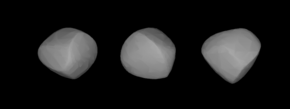
KNOWPIA
WELCOME TO KNOWPIA
Summary
Una (minor planet designation: 160 Una) is a fairly large and dark, primitive Main belt asteroid that was discovered by German-American astronomer C. H. F. Peters on February 20, 1876, in Clinton, New York.[8] It is named after a character in Edmund Spenser's epic poem The Faerie Queene (1590).
 A three-dimensional model of 160 Una based on its light curve. | |
| Discovery | |
|---|---|
| Discovered by | C. H. F. Peters |
| Discovery date | 20 February 1876 |
| Designations | |
| (160) Una | |
| Pronunciation | /ˈjuːnə/[1] |
| Main belt | |
| Orbital characteristics[2] | |
| Epoch 31 July 2016 (JD 2457600.5) | |
| Uncertainty parameter 0 | |
| Observation arc | 118.30 yr (43209 d) |
| Aphelion | 2.90877 AU (435.146 Gm) |
| Perihelion | 2.54727 AU (381.066 Gm) |
| 2.72802 AU (408.106 Gm) | |
| Eccentricity | 0.066257 |
| 4.51 yr (1645.8 d) | |
Average orbital speed | 18.01 km/s |
| 144.472° | |
| 0° 13m 7.471s / day | |
| Inclination | 3.82512° |
| 8.60989° | |
| 52.8418° | |
| Earth MOID | 1.56031 AU (233.419 Gm) |
| Jupiter MOID | 2.30107 AU (344.235 Gm) |
| TJupiter | 3.349 |
| Physical characteristics | |
| Dimensions | 81.24±2.1 km |
| Mass | 5.6×1017 kg (assumed) |
Mean density | 2.0? g/cm3 |
Equatorial surface gravity | 0.0227 m/s2 |
Equatorial escape velocity | 0.0429 km/s |
| 11.033 h (0.4597 d)[2] 0.234 d (5.61 h)[3][4] | |
| 0.0625±0.003[2] 0.063[5] | |
| Temperature | ~170 K |
| C[6] | |
| 9.08,[2] 8.95[7] | |
In the Tholen classification system it is categorized as a CX-type, while the Bus asteroid taxonomy system lists it as an Xk asteroid.[9] Photometric observations of this asteroid made at the Torino Observatory in Italy during 1990–1991 were used to determine a synodic rotation period of 5.61 ± 0.01 hours.[3]
References edit
- ^ Benjamin Smith (1903) The Century Dictionary and Cyclopedia
- ^ a b c d Yeomans, Donald K., "160 Una", JPL Small-Body Database Browser, NASA Jet Propulsion Laboratory, retrieved 12 May 2016.
- ^ a b di Martino, M.; et al. (February 1994), "Lightcurves and rotational periods of nine main belt asteroids", Icarus, 107 (2): 269–275, Bibcode:1994Icar..107..269D, doi:10.1006/icar.1994.1022.
- ^ "Lightcurves and map data on numbered asteroids N° 1 to 52225". Archived from the original on 27 November 2005. Retrieved 3 November 2008.
- ^ "Infrared Astronomical Satellite (IRAS)". Archived from the original on 24 February 2005. Retrieved 24 February 2005.
- ^ Asteroid Lightcurve Data File, Updated March 1, 2001
- ^ Warner, Brian D. (December 2007), "Initial Results of a Dedicated H-G Project", The Minor Planet Bulletin, 34 (4): 113–119, Bibcode:2007MPBu...34..113W.
- ^ "Numbered Minor Planets 1–5000", Discovery Circumstances, IAU Minor Planet center, retrieved 7 April 2013.
- ^ DeMeo, Francesca E.; et al. (July 2009), "An extension of the Bus asteroid taxonomy into the near-infrared" (PDF), Icarus, 202 (1): 160–180, Bibcode:2009Icar..202..160D, doi:10.1016/j.icarus.2009.02.005, archived from the original (PDF) on 17 March 2014, retrieved 8 April 2013. See appendix A.
External links edit
- 2011-Jan-24 Occultation / (2011 Asteroidal Occultation Results for North America)
- 160 Una at AstDyS-2, Asteroids—Dynamic Site
- Ephemeris · Observation prediction · Orbital info · Proper elements · Observational info
- 160 Una at the JPL Small-Body Database


